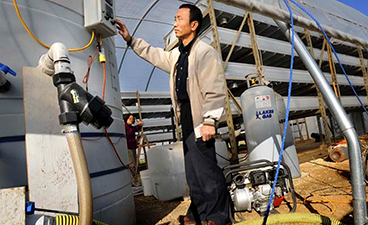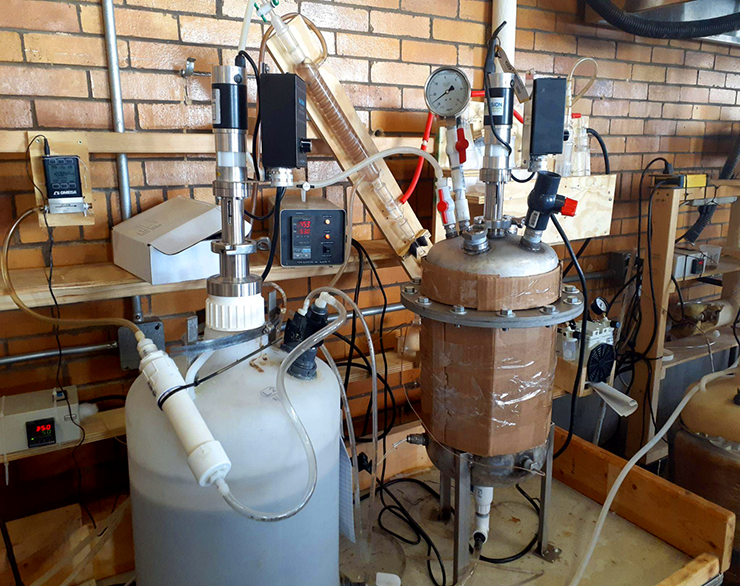Written by Ava Kian for Minnpost

Researchers at the University of Minnesota have long wanted to make something out of the millions of gallons of manure produced on the state’s farms.
Roger Ruan and a team of researchers have identified a process that does exactly that. It clears out certain harmful minerals from manure and preserves the ones that will be beneficial — in a way that can potentially benefit farmers and the economy.
The process relies on microbes that digest organic material to produce nitrogen fertilizer and methane gas. It also uses microalgae that extracts nutrients from the manure, which can then be used to produce animal feed and biofuels. The last step involves applying mineral solutions to wastewater to extract pollutants before it is released into the environment.
Wasting valuable nutrients
Minnesota is the second-largest producer of hogs in the United States. On March 1, 2023, there were 8.9 million hogs and pigs on Minnesota farms, according to the USDA.
According to the Minnesota Pork Producers Association, the state has more than 3,000 hog farms. While many farms implement precision manure application, which reduces the amount of waste going into water sources, there are still environmental risks associated with those practices, said Ruan, a professor and the director of the Center for Biorefining at the university.
A 2020 report from the Environmental Working Group, a national organization, found that in 69 of Minnesota’s 72 agricultural counties, nitrogen from manure combined with nitrogen in fertilizer exceeded the recommendations of the Minnesota Pollution Control Agency and the University of Minnesota. The EWG estimated that Minnesota’s feedlots produce an estimated 49 million tons of manure annually from dairy cows, beef cows, turkeys, hogs and chickens.
Traditional methods of manure management involve applying manure as fertilizer and using ponds or water bodies for storage. But that manure application many times wastes valuable nutrients, Ruan said, and can result in nutrients like nitrogen running off into water.
Farmers view manure as a commodity and don’t want it to go to waste, said Jay Moore, a brand strategist for Bioverse Healthy Farms, a company that sells environmental products to hog farmers and dairy farmers.
For years, farmers have used manure generated from either their farms or other farms instead of commercial fertilizer. “Manure is a valuable commodity to the farmers in Minnesota,” he said.
Moore estimated that a barn that holds 1,000 animals would generate anywhere from 300,000 to 350,000 gallons of manure a year. He previously worked at New Fashion Pork, a company that owns hog facilities and feed mills in Minnesota, Iowa, Wyoming, South Dakota, Illinois, Indiana and Wisconsin. Each year, New Fashion Pork applies around 60 million gallons of manure to the land, he estimated.
But as more farmers implement no-till farming — a process that involves strategically placing manure in rows using a GPS — they are using much less manure.
“You share with the farmers, sell it to your neighbors, which is a positive thing because, environmentally, you’re using less and producing a better yield,” Moore said. “In the spring, you’re going to come back to those exact GPS coordinates and put your kernel of corn or soybean or whatever you’re planting right where you injected that manure.”
Hog manure tends to have more nitrogen than carbon. Because of that, the manure needs to go through some sort of carbon-nitrogen adjustment. The methane gas in the manure can then be removed from the manure, and that gas can be pressurized to become renewable natural gas.
“Right now there’s a lot of interest in that because it is considered as a low-carbon fuel,” Ruan said.
California, for example, incentivizes the use of low-carbon fuel gasses, having implemented a credit for companies that use them in 2011. Ruan said many farms in Minnesota already convert manure methane into natural gas and sell it to companies in California. That process, known as “methane digesting,” is more common in the dairy industry than the pork industry because of the makeup of hog manure and because hog barns are often spread across larger areas, making it harder to “feed” the digester.
The university’s research has found ways to condition the nutrients in manure to produce algae and to help grow hydroponic plants, which could serve as feed for animals or go directly to people, Ruan said.

The process they’ve identified uses many of the nutrients to create something else of value. “This way you can produce a lot of different products at the same time,” he said. “You can produce all these fertilizers, and you can produce methane, use the remaining wastewater to grow algae, which can be used as feedstock. And you can also use the remaining conditioned wastewater to grow hydroponic plants.” A side benefit, he said, is that this process also prevents the spread of viruses that sometimes will be spread through manure.
Lowering the cost
Ruan is encouraged by the market for renewable natural gas — one of the byproducts of this process. Right now, the cost is high because the process is labor-intensive. But with the help of robotics and sensors, he said it could be improved.
Research is ready to be on a larger scale, Ruan said. Researchers need to find a site for a larger demonstration to showcase that it is operational and also profitable. They’re currently looking for commercial partners and funding to start.
A similar process is possible for manure from other animals, although it would need to be slightly adjusted, Ruan said.
He has applied for grant funding through the Legislative-Citizen Commission on Minnesota Resources. That body received 214 proposals requesting approximately $183 million — although it has $90 million available to give to projects.
Ruan will have a better idea this summer whether his proposals will be chosen. The commission will present the proposal to the Legislature for money from the state’s Environment and Natural Resources Trust Fund.